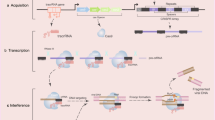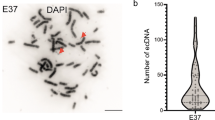Abstract
Loss of heterozygosity (LOH) analysis, performed in 68 γ-radiation-induced primary thymic lymphomas of F1 hybrid mice, provided evidence of significant LOH on chromosome 19 in a region defined by the D19Mit106 (22 cM) and D19Mit100 (27 cM) markers (Thymic Lymphoma Suppressor Region 8, TLSR8). Cd95 and Pten, two genes mapped at this region, were inactivated in a vast majority of these tumors (85.3% for Cd95 and 61.8% for Pten). Moreover, altered expression of Cd95 and Pten occurred concomitantly in 34 of 68 (50%) thymic lymphomas suggesting a coordinated mechanism of inactivation of these genes. Surprisingly, we also found that Jak2, a proto-oncogene located between Cd95 and Pten, was simultaneously inactivated in a significant fraction of the tumors analysed (24 of 34, 70.6%). Taken together these findings and the lack of mutations in the coding sequences of the mentioned genes clearly suggest a possible regional epigenetic inactivation mechanism on mouse chromosome 19 operating during the development of these tumors.


Similar content being viewed by others
References
Baylin SB, Herman JG . 2000 Trends Genet. 16: 168–174
Butler LM, Dobrovic A, Cowled PA . 2000 Br. J. Cancer 82: 131–135
Cairns P, Okami K, Halachmi S, Halachmi N, Esteller M, Herman JG, Jen J, Isaacs WB, Bova GS, Sidransky D . 1997 Cancer Res. 57: 4997–5000
Dahia PL, Fitzgerald MG, Zhang X, Marsh DJ, Zheng Z, Pietsh T, von Deimling A, Haluska FG, Haber DA, Eng C . 1998 Oncogene 16: 2403–2406
Dahia PLM, Aguiar RC, Alberta J, Kum JB, Caron S, Sill H, Marsh DJ, Ritz J, Freedman A, Stiles C, Eng C . 1999 Hum. Mol. Genet. 8: 185–193
Dammann R, Li C, Yoon J-H, Chin PL, Bates S, Pfeifer GP . 2000 Nature Genet. 25: 315–319
Dubrova YE, Plumb M, Gutierrez B, Boulton E, Jeffreys AJ . 2000 Nature 405: 37
Feinberg AP . 1993 Nature Genet. 4: 110–113
Feinberg AP, Rainier S, DeBaunn MR . 1995 J. Natl. Cancer Inst. Monogr. 17: 21–26
Herranz M, Santos J, Salido E, Fernández-Piqueras J, Serrano M . 1999 Cancer Res. 59: 2068–2071
Liu R, Liu C-B, Golam Mohi M, Arai K, Watanabe S . 2000 Oncogene 19: 571–579
Malumbres M, Pérez de Castro I, Santos J, Meléndez B, Mangues R, Serrano M, Pellicer A, Fernández-Piqueras J . 1997 Oncogene 14: 1361–1370
Malumbres M, Pérez de Castro I, Santos J, Fernández-Piqueras J, Pellicer A . 1999 Oncogene 18: 385–396
Matsumoto Y, Kosugi S, Shinbo T, Chou D, Ohashi M, Wakabayashi Y, Sakai K, Okumoto M, Mori N, Aizawa S, Niwa O, Kominami R . 1998 Oncogene 16: 2747–2754
Meléndez B, Santos J, Fernández-Piqueras J . 1999 Oncogene 18: 4166–4169
Okumoto M, Park Y-G, Song C-W, Mori N . 1999 Cancer Lett. 135: 223–228
Podsypanina K, Hedrick-Ellenson L, Nemes A, Gu J, Tamura M, Yamada KM, Cordón-Cardo C, Catoretti G, Fisher P . 1999 Proc. Natl. Acad. Sci. USA 96: 1563–1568
Sachs RK, Hiatky LR, Trask BJ . 2000 Trends Genet. 16: 143–146
Santos J, Pérez de Castro I, Herranz M, Pellicer A, Fernández-Piqueras J . 1996 Oncogene 12: 669–676
Santos J, Herranz M, Pérez de Castro I, Pellicer A, Fernández-Piqueras J . 1998 Oncogene 17: 925–929
Suzuki A, De la Pompa JL, Stambolic V, Elia AJ, Sasaki T, Del Barco-Barrantes I, Ho A, Wakeham A, Itie A, Khoo W, Fukumoto M, Mak TW . 1998 Curr. Biol. 8: 1169–1178
Watanabe-Fukunaga R, Brannan CI, Copeland NG, Jenkins NA, Nagata S . 1992 Nature 356: 314–317
Whang YE, Wu X, Suzuki H, Reiter RE, Tran C, Vessella RL, Said JW, Isaacs WB, Sawyers CL . 1998 Proc. Natl. Acad. Sci. USA 95: 5246–5250
Yu C-L, Jove R, Burakoff SJ . 1997 J. Immunol. 159: 5206–5210
Acknowledgements
This work was supported in part by grants PM99/003 (Ministerio Educación y Cultura, Spain) and 08/0043/1998 (Comunidad Autónoma de Madrid, Spain) to J Fernández-Piqueras, and BMH4-98-3426 (BIOMED 2 program, European Union) and 08/0008/1999 (Comunidad Autónoma de Madrid, Spain) to J Santos.
Author information
Authors and Affiliations
Rights and permissions
About this article
Cite this article
Santos, J., Herranz, M., Fernández, M. et al. Evidence of a possible epigenetic inactivation mechanism operating on a region of mouse chromosome 19 in γ-radiation-induced thymic lymphomas. Oncogene 20, 2186–2189 (2001). https://doi.org/10.1038/sj.onc.1204297
Received:
Revised:
Accepted:
Issue Date:
DOI: https://doi.org/10.1038/sj.onc.1204297
- Springer Nature Limited
Keywords
This article is cited by
-
The stromal gene encoding the CD274 antigen as a genetic modifier controlling survival of mice with γ-radiation-induced T-cell lymphoblastic lymphomas
Oncogene (2010)
-
Functional Fas (Cd95/Apo-1) promoter polymorphisms in inbred mouse strains exhibiting different susceptibility to γ-radiation-induced thymic lymphoma
Oncogene (2006)
-
Evidence for a new tumour suppressor gene locus for γ-radiation-induced thymic lymphoma located on the proximal part of mouse chromosome 18
Clinical and Translational Oncology (2004)
-
Genetic interactions between Pten and p53 in radiation-induced lymphoma development
Oncogene (2003)
-
A new locus for resistance to γ-radiation-induced thymic lymphoma identified using inter-specific consomic and inter-specific recombinant congenic strains of mice
Oncogene (2002)




